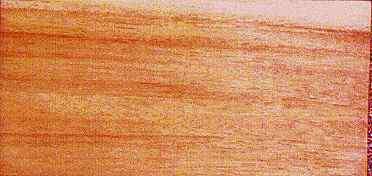
Bijasal (Pterocarpus marsupium)
Family: Dipterocarpaceae
Common names: Angu, Bebe, Bijasal, Huevos de gato, Indian Padauk, Lagunero, Mututi, Nogal falso, Padauk, Palo de pollo, Pau sangua, Sangre, Sangre de drago, Sangrillo, Yaya sangre
Distributed in: India (Oceania and S.E. Asia)
Distribution overview: The genus Pterocarpus consists of over 60 species of small and large trees that occur widely in the tropics. Pterocarpus marsupium is widely distributed in Central and South India, mainly on hilly areas at altitudes of 490 to 1475 feet (150 to 450 m), but occasionally reaching up to 3270 feet (1000 m) or more. It is found also in Orissa and Bihar and extends eastwards to the sub-Himalayan tract up to Kumaon.
Common uses: Beams, Building construction, Cabin construction, Clogs, Concrete formwork, Construction, Crossties, Decks, Factory construction, Farm vehicles, Form work, Foundation posts, Framing, Handles, Heavy construction, Joists, Light construction, Porch columns, Railroad ties, Rough construction, Shafts/Handles, Structural work, Tool handles, Wheel spokes, Wheels , Windows
Environment profile: Status has not been officially assessed
Tree size: Trunk diameter is 100-150 cm
Colors: the heart isTan, Whiteand the sapwoodWell defined, White to yellow.The grain isModerately interlocked, the textureMedium
Natural durability: Sapwood is susceptible to wood broing insects , Very good weathering properties
Drying Defects: Slight surface checking, Slight twist/warp
Ease of Drying: Green conversion and stacking in open piles is recommended
Comments: The timber is reported to contain a dye which dissolves readily in cold water to stain the a wood yellowish color, and also impart a characteristic yellowish-blue flourescence to the waterWood contains yellow dye
Blunting Effect: Abrasive material in pores may dull cutting edges
Boring: Fairly easy to very easy
Carving: Fairly Easy to Very Easy
Cutting Resistance: Surfaces tend to be woolly
Gluing: Fairly Easy to Very Easy
Mortising: Fairly Easy to Very Easy
Moulding: Fairly Easy to Very Easy
Movement in Service: Fairly Easy to Very Easy
Nailing: Fair to Good , Fairly Easy to Very Easy
Planing: Planes to a poor finish
Resistance to Impregnation: Sapwood is permeable
Sanding: Fairly Easy to Very Easy
Veneering qualities: Rotary cutting is not recommended due interlocked grain and aberasive material , Suitable for slicing
Steam bending: Poor to Very Poor Results
Polishing: Good; Staining: Fairly Easy to Very Easy; Varnishing: Heavy varnish used to prevent discoloration and staining in contact with water
;
- Numerical data Metric
- Numerical data English
- Strength properties
- References
 |
 |
 |
 |
| Item |
Green |
Dry |
Metric |
| Specific Gravity |
0,65 |
0,69 |
|
| Density |
|
785 |
kg/m3 |
| Bending Strength |
730 |
1351 |
kg/cm2 |
| Crushing Strength |
357 |
669 |
kg/cm2 |
| Hardness |
|
|
kg |
| Impact Strength |
126 |
104 |
cm |
| Shearing Strength |
|
|
kg/cm2 |
| Stiffness |
100 |
131 |
1000 kg/cm2 |
| Tangential Shrinkage |
6 |
|
% |
| Radial Shrinkage |
4 |
|
% |
| Weight |
929 |
769 |
kg/m3 |
| Maximum Load |
|
|
cm-kg/cm3 |
| Toughness |
|
|
cm-kg |
| Static Bending |
|
|
kg/cm2 |
|
 |  |  |  | | Item | Green | Dry | English | | Bending Strength | 10384 | 19227 | psi | | Density | | 49 | lbs/ft3 | | Impact Strength | 50 | 41 | inches | | Maximum Crushing Strength | 5087 | 9523 | psi | | Stiffness | 1429 | 1866 | 1000 psi | | Specific Gravity | 0.65 | 0.69 | | | Weight | 58 | 48 | lbs/ft3 | | Radial Shrinkage | 4 | | % | | Tangential Shrinkage | 6 | | % | | Volumetric Shrinkage | 10 | | % | |
Very heavy
Density = high
Compression strength (parallel to grain) = very high
Bending strength (MOR) = very high
Limaye, V.D.1954. Grouping of Indian Timbers and their Properties, Uses and Suitability. Indian Forest Records, New Series. Timber Mechanics, Vol. 1, No. 2, Forest Research Institute, Dehra Dun, India.Limaye, V.D. and B.R. Sen. 1953. Weights and Specific Gravities of Indian Woods. Indian Forest Records, New Series. Timber Mechanics, Vol. 1, No. 4, Forest Research Institute, Dehra Dun, India.Rao, K.R. and S.K. Purkayastha. 1972. Indian Woods - Their Identification, Properties and Uses, Volume III - Leguminosae to Combretaceae. Published by the Manager of Publications, Delhi, India.
|








